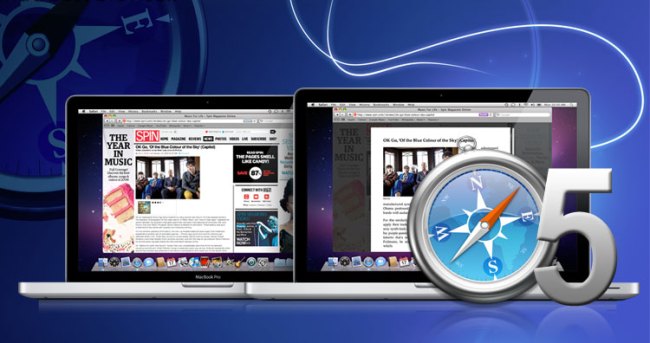You have to feel at least a twinge of sympathy for Apple’s Safari developers. Somewhere between retina displays, A4 processors and video conferencing on the iPhone 4, news of Apple’s brand new Safari release, version 5, seems to have been completely buried by the fourth coming of the God phone. But if you’re not looking to drop and pray at the altar of Apple’s next mobile creation, Safari 5 holds plenty of promise for the desktop- and notebook-bound, including claims of improved performance, a new smart address field, and even an innovative feature that strips ads and other distractions out of long articles.
Does it hold up to Apple’s hyperbolic marketing? We gave the browser’s new features a whirl to find out.
 Safari Reader
Safari Reader
To those who have embraced digital reading on the likes of the Amazon Kindle or even Apple’s own iPad, reading on the Web after devouring e-books can feel like a big step backwards. All those pictures, ads, menus, user comments, and other “rich multimedia” add up to a lot of… well, clutter. Safari Reader attempts to alleviate the information overload by recognizing articles and automatically stripping out the mess around it, producing a clean version that’s literally fit for print.
After Safari recognizes what it thinks is an article, a grey “Reader” button appears within the address bar. Click it, and a paper-like scroll slides up from bottom of the page, dimming out the original Web content and replacing it with a text-only version, as if you copied the entire article manually and pasted it into Word. Headlines take on old-timey newspaper proportions, the print stretches to easily legible size, and all but the most relevant pictures disappear. Although links remain, the automatically inserted ad links no longer pop up on hover, and a change in color to a uniform dark blue that makes them less obtrusive.
In other words, it’s clean. Considering modern research on the potentially adverse effects of reading on the Web, a feature like this could actually help increase comprehension by blocking out noise. And frankly, when you run into more than a few paragraphs you want to consume thoughtfully, opening it in Reader feels downright refreshing. It’s as close to printing it out, brewing a cup of coffee and carrying it to the library as you can get without leaving your desk chair. Still, like a lot of Apple features, we wish it had a few more buttons and knobs. For instance, you can zoom in and out, but you can’t choose which font it will use, tweak options for photos, or choose to eliminate links entirely.
 Search
Search
Safari has long included a search bar alongside the address bar up top, but this time around, you can actually select your search engine of choice. Clicking on the magnifying glass icon lets you choose between Yahoo, Bing and Google, along with previous searches. While it’s a welcome change, it really only brings Safari up to speed with the likes Internet Explorer, and Firefox, which have had the ability to choose for ages, and still offer more search providers (Firefox, for instance will let you perform an eBay, Wikipedia or Amazon search in a snap). We really prefer Chrome’s combined search and address bar to all three competitors, which eliminates the need to select a box at all.
Speed
Ever since Chrome appeared on scene with wild – and surprisingly accurate – claims of its own speed superiority, every competing browser has made its own cries of greased-up performance on new browser versions. Safari 5 is no different, with a handful of colorful bar graphs on Apple’s site demonstrating how it allegedly stomps competing browsers in benchmarks on the Mac.
Great, but how does it actually perform? We dodged the artificial benchmarks you can find at many other sites and jumped straight to the biggest measurement of perceived browser speed: page load times. We lined up Safari 5, Chrome 5, Internet Explorer 8, and Mozilla Firefox 3.6 on a PC to see how each performed in real-life load tests on some of our most commonly visited sites. Here’s how they fared.
|
Site |
Apple Safari 5 |
Google Chrome 5 |
Microsoft IE8 |
Mozilla Firefox 3.6 |
|
CNN.com |
9.3 |
6.5 |
4.9* |
6.5 |
|
Yahoo.com |
3.6 |
1.7 |
2.2 |
2.0 |
|
Digitaltrends.com |
2.8 |
2.1 |
2.8 |
2.1 |
|
NYTimes.com |
3.1 |
2.6 |
2.7 |
3.5 |
|
YouTube.com |
2.6 |
2.3 |
1.3 |
2.2 |
|
PennyArcade.com |
1.7 |
2.6 |
1.4 |
3.1 |
*Despite posting the quickest load time for CNN.com, IE8 also repeatedly posted “stack overflow” errors for the site and crashed.
Small and unscientific as the sample size is, these tests give a reasonable idea about the time you’ll spend waiting to go from blank screen to fully loaded page, which is what most Web surfers are primarily concerned with. Contrary to Apple’s suggestion that Safari would prove to be the cheetah of the pack, it often came in last, and never once broke the tape at the finish line. A few fractions of a second don’t add up to dismiss it entirely, but its speed can still be considered a liability more than an advantage.
 Smart Address Bar
Smart Address Bar
Search engines have spoiled us. Most of us no longer expect to type full words or search terms simply because on-the-fly search suggestions and predictive text entry make it easy to tap in the first few letters and hit enter. Safari now steps in line with a smart address bar that offers previously visited sites and “top hits” as you type. A simple F or Y will bring up Facebook and YouTube, respectively, and further tapping calls up bookmarks and previously visited sites.
Simple? Yes. Functional? Absolutely. But a lot like the improved search, it’s just a step toward functionality other browsers have offered for a long time.
Safari Developer Program
Apple’s Safari Developer Program promises to move Safari in the same direction as Firefox by opening it to third-party tweaking and extensions. Unfortunately, Apple’s promised Safari Gallery Extension won’t go live until later on, so we’re not yet able to report how well Apple has implemented it – or how much support it will see from developers. According to Apple, it will developers to use existing Web languages like HTML5, JavaScript and CSS3 to change the toolbar, extension bar, change the way Web content appears, and control Web pages.
Verdict
Safari 5 gives Apple’s long-neglected browser an important dose of upgrades, but it’s still a late bloomer showing up to the party with many of the same goods as everybody else. With one outstanding exception: The Reader function stands out as both an innovative and genuinely functional feature that we suspect competitors will scramble to follow. Chrome remains faster, and Firefox more customizable, but if you’re the type of Internet user with The Atlantic on your bookmarks toolbar instead of YouTube, the refreshment of scrubbing down Web copy might just be worth the switch.
Editors' Recommendations
- The best web browsers for 2024
- The 5 best MacBooks for video editing in 2024
- Best Apple Studio Display deals: Save $100 on 5K monitors
- The 5 best laptops for Photoshop
- How to change your language in Google Chrome on desktop






